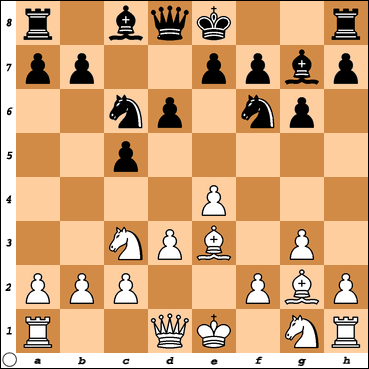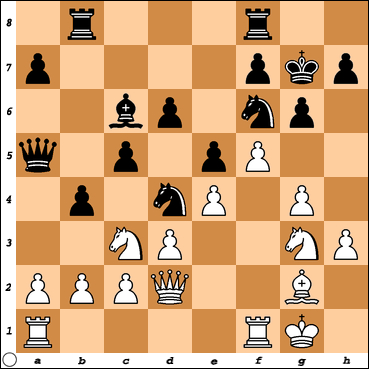That said, we now at least have the "Prohibition" series at the Charlotte Chess Center, playing one game a week on Tuesday nights. It's not much, but it's something, and hopefully will allow for somewhat more frequent publication here.
This week, we are going to look at a game from this past Tuesday. As the article title implies, we are going to see a theme in this game that has been seen multiple times before, and not always with the same opening.
First, if you look at The French Connection: Volume 31, you will see that we have an Advance French where Black's Light-Squared Bishop is not very good, but yet, it held Black's position together, and White eliminated it and won shortly after that.
Next, in the lone July publication, Game Analysis: Developing Your Pieces Wisely, we saw an offbeat Closed Sicilian with Black's Light-Squared Bishop ended up not being a very good piece, but yet again, the elimination of it was ultimately the move the caused Black to resign!
Well, this time, we are going to be looking at a more mainstream line of the Closed Sicilian, and you guessed it, Black's Light-Squared Bishop ends up not being very good, but getting rid of it is exactly what White does, and this time, it will lead to a local piece superiority for White on the Kingside, where ultimately a "4-on-2" scenario will force Black's resignation.
So without further ado, let's take a look at the feature game:
Prohibition, Round 2
W: Patrick McCartney (2059)
B: Garrett Browning (1734)
Closed Sicilian
1.e4 c5 2.Nc3 g6 3.g3 Bg7 4.Bg2 Nc6 5.d3 Nf6
While this move is ok, more common, and more flexible, is 5...d6. As we will see, Black will end up playing this move anyway, and actually it's Black's very next move. However, this gives away Black's plan. One unique feature about the Closed Sicilian is that there is a ton of flexibility, and often times, one line can easily transpose into another.
For example, after 5...d6, the two main lines for White are 6.Be3 and 6.f4, and then there are also the slightly offbeat lines which mainly involve developing the King's Knight, whether it be the most common 6.Nge2, Duncan Suttles' favorite move, 6.Nh3, or even in some cases, though not common in the Closed Sicilian without advancing the f-pawn first, the move 6.Nf3 is occasionally played.
Against the two main lines, Black has 6...e6, 6...e5, 6...Rb8, and 6...Nf6 all as legitimate options against both main moves, and they can easily transpose into each other. For example 6.Be3 Rb8 7.Qd2 b5 8.f4 can also arise from 6.f4 Rb8 7.Be3 b5 8.Qd2. While theoretically, with best play, the Closed Sicilian is basically equal, the massive number of options, and accounting for all the transpositions between the 6.Be3 and 6.f4 lines, can easily cause Black to wrongfully intertwine ideas across different lines, especially when transpositions actually do occur.
So the moral of the story is, flexibility is almost always better than early commitment, but flexibility can also bite you if you are unable to account for all scenarios in what is a fluid situation.
6.Be3 d6

So now we have the line with 6.Be3 Nf6. This response by Black is actually slightly tricky. While not an issue against 6.f4, when White plays 6.Be3, he has to watch out for ...Ng4 tricks by Black. The reason for White to play an early 6.Be3 is actually to trade off the Bishop in most cases, but White does not want Black's Knight for it. He wants Black's fianchettoed Bishop, leaving Black with weak dark squares on the Kingside.
Therefore, to prevent this issue, White's next move is actually forced.
7.h3
Preventing 7...Ng4.
7.O-O 8.Qd2 Bd7
In the other Closed Sicilian article referenced in the introduction, we saw Black play an early ...Be6, which turned out to not be very good, despite the number of decent options that Black had. It got kicked back with an early f5 by White, and remained passive. Here, once again, we see Black with a number of decent options. Guess what? Moving this Bishop wasn't one of them. It can sit passive on d7, or it can sit passive on c8, and actually, from c8, it's more flexible as it can also to go b7 or even sometimes a6 becomes a good square for the Bishop with White's Bishop being fianchettoed. Why waste a move relocating a piece from one passive spot to another. It is not like it is immediately in the way of the other pieces. Seeing White's goal is to eliminate the dark-squared Bishops and execute a direct attack on the Kingside, Black's focus should be on the Queenside or in the center, and therefore, Black is best off playing either 8...Rb8, getting off the diagonal of White's g2-Bishop and also promoting the idea of storming the b-pawn down the board. The other idea is to play ...Nd4 and ...e5, which in this case, since the White Knight has not been developed yet to e2, Black can play these moves in either order. Had the Knight already been there, it might be most desirable to play ...e5 first and only then ...Nd4.
So we see multiple possibilities for Black that all focus on executing counter-play on the Queenside or down the middle. This Bishop move does none of that. That said, we are about to see White set up a Kingside attack, and eventually get Black to relinquish this piece that appears so passive and bad, despite it playing a fairly key defensive role. For example, take the French Defense, which is the first game in the introduction referenced, and take the Closed Sicilian. What is a key pawn break for both openings for White? The f5-push! Once the f-pawn is traded off, the f5-square for White's pieces can be a valuable source. If Black doesn't aggressively use the Bishop to attack down the f1-a6 diagonal or the long diagonal from b7, it can often be a valuable defensive piece to contest one of Black's weaker squares in this opening, f5. We will see White virtually force Black to relocate and then trade off this passive but valuable piece just like we did in the two games referenced at the beginning.
So what we see here is another case of mis-handling of what appears to be a bad piece that instead can play a vital role.
9.Bh6 Rb8 10.Nge2 Nd4
So now, suddenly, we see Black blending both of the ideas mentioned earlier, but why not do this without moving the Bishop and saving yourself a tempo?
At this point, due to the threat of the Knight deflecting the Queen away from the guarding of the h6-Bishop, it is time for White to release the tension and trade the Bishops.
11.Bxg7 Kxg7 12.g4
White starts his Kingside expansion, and opens up the g3-square for the Knight if Black doesn't trade soon.
12...Qa5
On one count, this move appears to be extremely annoying. White did not eliminate the Bishops just so that the Queens could get eliminated and we head closer to an endgame. White is ready to attack. On the flip side, this also puts a critical piece of Black's on the Queenside, and is one less piece to defend the King. Keeping in mind that Black is, for all intents and purposes, a move behind from the norm due to his Bishop move on move 8, going for the center and advancing his Queenside pawns may be better than trying to throw his pieces out to the Queenside. If it means Black wins a pawn eventually, or even two, so be it. White doesn't care. With this abandonment, White is going full-fledged at this point for a Kingside attack.
The best move here was probably 12...e5, with a fairly balanced position.
13.f4
Another thing should be noted here for those that want to play this line as White. In the 6.Be3 lines of the Closed Sicilian, where White often plays Qd2 early on, if there is a Black Knight on d4, you always have to watch out for forks of the King and Queen. This is especially true when there is a dangling pawn on h3, or if the Bishop is already on g4. In this particular case, it is not critical to advance before castling. But sometimes it is. For example, had White not already advanced g4, and the g-pawn was still on g3, then castling would be a big mistake because Black could then take the pawn on h3 with the Bishop because if White takes back, there is a royal fork on f3. By not castling, the Rook covers h3. Therefore, often times, this advancement of f4 can be critical before castling in these lines with a Queen on d2 so that when White does castle, there is no ...Bxh3 trick because the Bishop can recapture since the Rook on f1 would then cover the f3-square, which it is not covering if the pawn is still on f2.
Therefore, while this f4 move may not be critical in this particular scenario, even if White did castle now, he's gonna play f4 the next move anyway, so why not do it now? In addition, it takes advantage of Black not playing 12...e5. With 12...e5, Black can answer this move with 13...exf4, not allowing the f5-advance. Here, we will see Black play the move ...e5 a move too late, and White will get his pawn to the f5-square.
13...e5 14.f5 b5 15.O-O Bc6
Here, Black sees no future in the Bishop on its current diagonal, but we will see White now put f5 to good use. It was probably best for Black to play 15...Nxe2. Now the White Knight will move away, leaving the d4-Knight dangling out there, and we will soon see this become a problem for Black.
16.Ng3 b4

So what should White do here? Should he play 17.Nd5, enticing a trade from Black? Should he play 17.Nce2 offering a Knight trade? Should he play 17.Nd1, re-routing to e3? Should he play 17...Nb1, guarding the Queen? Or should he ignore it, let Black take, and attack the Kingside with a move like 17.fxg6 with ideas of 18.Qg5 if Black takes the Knight?
17.Nd5
It turns out this move and 17.Nd1, rerouting the Knight to e3 with an attack on the Kingside, are both very strong. 17.Nce2 is ok and enough for a slight edge for White, but no more. 17.Nb1 is just passive and not good at all, and 17.fxg6 just doesn't work in this case. Black can safely take the Knight and is simply winning with just a little bit of care taken for his King.
17...Bxd5 18.exd5
So here we see the theme again of the elimination of what appears to be a bad Bishop. Turns out it was simply passive, not bad. Now the d5-pawn will play an important role.
18...Rbc8
And now, with Black on the brink of defeat, White plays the wrong move here.
19.Nh5+?!
Correct here is either 19.c3 or 19.fxg6 and then 20.c3. The idea in the former case is that after 19...bxc3 20.bxc3 a6 (The pawn is pinned, and so the Knight doesn't need to move) 21.g5 Nd7 22.f6+ Kh8 23.Ne4 Nf5 24.Rxf5! gxf5 25.Nxd6 c4 (Black has nothing better here) 26.d4 exd4 27.Qxd4 Rcd8 28.Nb7 Qb6 29.Nxd8 Qxd4+ 30.cxd4 Rxd8 31.Rc1 h6 32.h4 Kh7 33.Rxc4 Kg6, the endgame is completely winning for White.
White still has a clear advantage after the game move, but the 19.c3 idea is outright winning.
19...Nxh5
The only move! 19...gxh5 20.Qg5+ gets the Knight back and Black's position is a train wreck.
20.gxh5 f6
Neither pawn can be taken. If either is taken with the g-pawn, you have the Qg5+ problem again. 20...Nxf5?? loses immediately to 21.Rxf5! and if 21...gxf5??, then 22.Qg5+ Kh8 23.Qf6+ Kg8 24.h6 and Black is mated on the next move.
21.fxg6!
The correct pawn to take with, opening up the f-file.
21...hxg6 22.hxg6?
This move throws away the advantage. 22.Be4! is the correct move. If 22...f5, White can ignore the threat and play 23.Qg5!, winning.
22...Qd8??
Black misses out on his one and only opportunity. 22...c4! and now it is White that has to play the right moves to draw the game. The idea is that 23.c3?? is too slow now and 23...bxc3 24.bxc3 cxd3! and the White c-pawn will fall. Therefore, White would have to settle for 23.Qf2 or 23.dxc4 with an equal position.

White to move and win!
23.c3!
This move does the trick. Remember how it was mentioned that the d5-pawn would play an important role? If you look at all the places the Knight can go, there is only one safe square, b5. This is about as far away from the action as possible. Black would like to play ...f5 to open up his Queen and bring his pieces to the defense of his King. However, with this move, White deflects the Knight away to la-la-land, and the f5-square will be in White's total control before Black is able to free his position via advancing the f-pawn. By blocking the f-pawn, the Queen and f8-Rook have limited effect on the defense of the Black King, and the c8-Rook and Knight are basically useless. Meanwhile, White can easily bring all of his pieces to the Kingside, creating a 4-on-2 scenario via putting his Bishop on e4, and tripling on the f-file with his heavy pieces, which will eventually swing to the g- and h-files and swarm the Black King to his misery.
23...Nb5 24.Rf5!
The blockading move that is key to White's victory.
24...Kxg6 25.Raf1 Rg8 26.Qf2 1-0
Black resigned as there is no stopping the attack. The moment the King goes to f7, in any attempt to run, the f6-pawn falls as does then the King, and if Black waits, White can play Be4 and then swing the heavy pieces to the g- and h-file.
So what we saw here is repeated themes from previous articles, including those involving different openings like the French Advance. It is critical to realize that when you study a subject like openings, it's not like you can compartmentalize each opening into its own little box like a bunch of separated hamsters. It's not like all ideas in the French don't apply to other openings - such as the game shown here and in the second referenced game in the introduction, where many of the ideas in the French, especially those ideas of White's, are virtually carbon-copied in the Closed Sicilian. This can be said for many other pairs of openings that do not even feature the same pawn structure, but the same ideas often apply.
Therefore, when studying openings, do not just think that each opening is by itself and that each have strictly their own ideas. If you truly put in the work to understand an opening, and all of it's ideas beyond the opening moves, you will soon realize that other openings can easily have the same or at least similar ideas, and that often can be, and should be, used to decide your opening repertoire as a whole. Some openings are simply night and day, like the French and the Grunfeld. There is very little, if anything, that can be learned from one of those openings and applied to the other. But openings like the French and the Sicilian (blockades and pawn breaks - d5 in the Sicilian, e5 in the French, along with levers, like f5 for White) or the Queen's Gambit and Nimzo-Indian (Carlsbad Pawn Structure, the e4-lever for White, etc) can have extremely similar ideas and this should be used to your advantage when trying to expand your repertoire, rather than saying something like "Man, I'd tired of the Sicilian Najdorf, let's put all the other King Pawn openings in a hat and draw one at random for what I should study next!". In cases like that, you really are starting over, but that is not at all necessary. Those that have known me for the full 25 years that I've played will know that while I have played the French religiously that I have also played the Sicilian (Najdorf and Taimanov), and there is a reason that I played those, and not something random like the Pirc, which I haven't played since 1996 except the couple of rare cases that come from a transposition from the King's Indian Defense where usually it's an insipid line by White that gives him nothing, but the Pirc proper I have not played since the 90s.
Greater success will come if you put together a repertoire that meshes together well rather than random selection and thinking of "Studying White", "Studying Black vs e4" and "Studying Black vs d4" as three separate projects. It shouldn't be. It should be one big project where everything goes together nicely.
This concludes this article on "Different Openings Doesn't Mean Different Ideas". Until next time, good luck in whatever games you are able to play, and stay safe during this pandemic.


















